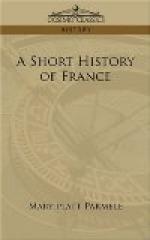This was a pet theory with Henry, and the subject of much discussion with Sully and of negotiation with Elizabeth, Queen of England, at the very time when Philip II. of Spain, in pursuance of a precisely opposite policy, had been moving heaven and earth to bring about a marriage with that extraordinary sister of his dead wife Mary. Henry did not witness the realization of his dream. But time has justified its wisdom, and modern statesmanship has been able to devise no wiser plan than that conceived in the mind of this enlightened king nearly three centuries ago.
How much France lost by Ravaillac’s dagger can only be surmised, and when Henry, fatally stricken (1610), was carried dying into the Louvre, a cry of grief arose from Catholic and Protestant alike throughout the kingdom. After a reign of twenty-one years, the sagacious ruler, who had done more than any other to make the country great and happy, was the victim of assassination. And France once more was the sport of a cruel fate which placed her in the hands of a woman and a Medici. Marie, the widow of Henry IV., was appointed regent during the minority of her son Louis aged ten years.
The regency of this woman is a story of cabals and the intrigues of aspiring favorites. If Marie had not the ability of her great kinswoman Catharine, it must be confessed neither had she her darker vices. She was simply intriguing and vulgar, and the willing instrument for designing people cleverer than herself. So powerful was the influence of Eleonora Galigai and her husband, Concini, both Italians like herself, that in that superstitious age it was ascribed to magic. Marie became the mere secretary to record the wishes of these parasites. Concini was made marquis, then minister. Whom he commended was elevated, and whom he denounced was abased. Public indignation reached its climax when this adventurer was finally created Marshal of France, before whom counts and dukes must bow. So furious was the storm raised by this, that Marie declared her willingness to surrender the regency, and after summoning the States General she presented her son, Louis XIII., thirteen years of age, declaring that he was qualified to reign.
Only once again was this body to be called together. That was in 1789, by Louis XVI., when it was transformed into a National Assembly.
But when it was discovered that the power of the detested pair was as great behind the boy king as it had been behind his mother, the storm gathered again from all parts of the kingdom. It was France in struggle with Concini, the man who was audaciously sending princes of the blood and dukes to the Bastille.
But a counter-influence was weaving about Louis. He was made to realize the indignity to himself in letting two vulgar Italians usurp his authority. Thus Albert de Luynes, his adored friend, procured his signature to a paper ordering the immediate destruction of Concini and his wife. And when Louis had seen Concini despatched by his own agents in the court of the Louvre, and the arrest, trial, and execution of Eleonora (upon the charge of sorcery), he completed the work by banishing his mother, only to fall immediately into the power of Albert de Luynes, himself an intriguing parasite, who intended to play the very same role as the pair he had overthrown.




